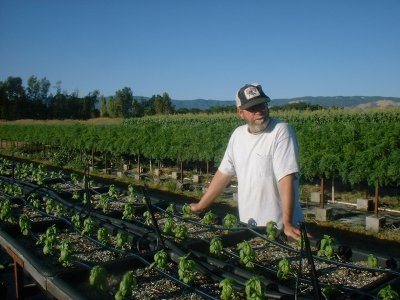
Strawberry season in Lake County has officially arrived. I had my first taste of the local season this week.
Just as I was biting into one of the red jewels, I could hear my son say “Wow!” in the background as he bit into his. Seconds later, my husband’s “Wow!” was heard. They’re that good when they’re fresh and local.
We visited Sky Hoyt’s Kelseyville farm and brought home a flat. If you’re hankering for some of Sky’s berries, you’ll find him at the Steele Winery farmers’ market on Saturday mornings. He has some pretty interesting farming methods which we’ll chat about later, but for now, let’s talk berry.
Strawberries are not actually berries at all, at least not by botanists’ standards. True berries have their seeds on the inside (think blueberries or cranberries) and, as you know, strawberry seeds are on the outside.
The yellow seeds covering the outside of the berry are considered individual fruits, with the sweet, fleshy part of the strawberry being the receptacle for the roughly 200 tiny fruits that cover it.
They’re members of the same family tree as the rose; in fact, in Italian strawberries are known as “fragola,” derived from the Latin word for fragrant.
They’re surprisingly nutritious. Only eight medium-sized berries provide 140 percent of our daily requirement for Vitamin C. They contain high amounts of antioxidants, which account for their bright red color. In addition, they’re a good source of folic acid, potassium and fiber.
They’re wonderful eaten fresh out of hand, sliced on cold cereal or yogurt, tossed into fruit smoothies, served on a sandwich with cream cheese and fresh mint, or added to a spinach salad (for which I’d recommend a poppy seed dressing or balsamic vinaigrette).
I love serving them fresh with balsamic vinegar and my recipe for that is below. While the combination of ingredients in the recipe may seem surprising, they work well together. The balsamic vinegar really makes the berry flavor pop.
A strawberry port wine reduction is fantastic on vanilla ice cream. For an added treat, soften the ice cream and mix in a bit of freshly ground pepper.
Strawberries should be stored in a cool, humid place; namely, your refrigerator with some special precautions. They’ll dry out without moisture, but go bad when sitting in too much dampness.
To store your strawberries, place them unwashed in a tightly covered plastic container or zipper sealed plastic bag with layers of paper towel between the berries. (Make sure to remove any bruised or moldy berries first.) The sealed container provides a humid environment and protects them from the drying effects of the fridge, while the paper towel soaks up excess moisture. I learned this method years ago from a strawberry grower at a farmers’ market and it hasn’t failed me yet!
If you’re not going to use your berries within a day or two, they should be frozen. To do this, stem, wash and dry the berries. Line a baking tray with waxed or parchment paper and place the strawberries on it with some space between them. Cover with plastic wrap and pop the tray in the freezer till the strawberries are frozen solid, then store them in zipper sealed plastic bags. Some folks roughly chop the berries and freeze in plastic tubs. That works well, too.
Frozen berries are fantastic in icy smoothies or pureed to make healthy popsicles for the kids. I like to make a fruity topping for pancakes or waffles by cooking frozen berries with a bit of water and sugar till it liquefies and then thickens into a syrupy consistency.
Now that you’ve got some practical ideas for strawberries, let’s travel back to Sky Hoyt’s farm.
Some years ago, Sky devised a clever method to grow strawberries that not only reduces harvest time backaches, but produces a better berry as well. Using salvaged material, Sky set up 12 long rows of growing tables to hold tubs of potting soil, into which he planted strawberries. (He also uses them for other crops, such as basil and carrots.) The soil is covered with white coated plastic and netting hovers above to keep hungry birds away. Ripening berries rest atop the plastic, rather than on dirt, to prevent rotting. Harvesting is made easier with the plants at waist level, as is tending the plants and checking for pests.
Sky uses a hybrid farming method, dubbed SAFE farming, that combines organic and non-organic methods for growing crops. (He’ll be happy to share a flyer with you at the farmers’ market.) His berry of choice is the Albion variety, a switch from last year’s Seascape, which can be harvested from May till October.
In Medieval times strawberries were associated with love. Whether or not they’re able to influence human love, these tasty, healthy berries are well worth your affection. Enjoy them while the local season lasts!
Strawberries with balsamic vinegar
This is a delightful way to serve this summer fruit. The balsamic vinegar brings out the flavor and color of the berries. It’s a refreshing dessert as is, or may be used as a topping for ice cream, shortcake or other desserts.
1 pint strawberries, washed, hulled and quartered
3 tablespoons balsamic vinegar
2 tablespoons sugar
Freshly ground black pepper to taste
Combine first three ingredients and marinate for about an hour (but no more than four). Add freshly ground black pepper to taste just before serving.
Esther Oertel, the "Veggie Girl," is a personal chef and culinary coach and is passionate about local produce. Oertel owns The SageCoach Personal Chef Service and teaches culinary classes at Chic Le Chef in Hidden Valley Lake. She welcomes your questions and comments; e-mail her at This email address is being protected from spambots. You need JavaScript enabled to view it..
Follow Lake County News on Twitter at http://twitter.com/LakeCoNews and on Facebook at http://www.facebook.com/pages/Lake-County-News/143156775604?ref=mf .
